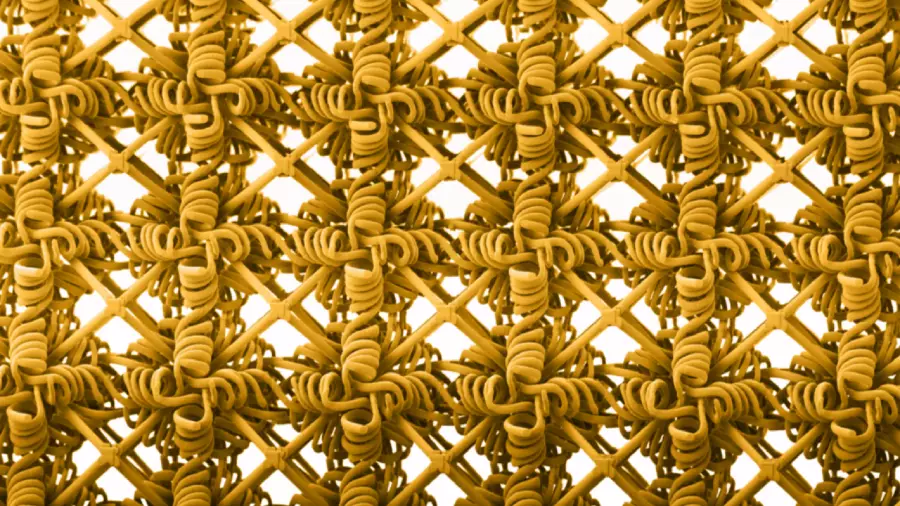When one thinks of innovation in computing, typical notions often involve software interfaces, hardware improvements, or even design aesthetics. However, a groundbreaking achievement from MIT researchers has shifted the spotlight to metamaterials—an ingenious blend of strength and stretch, challenging our preconceived notions of what materials can offer in technology. This metamaterial is not only an engineering marvel but also a symbol of the future, where the rigidity of traditional components meets the pliability of advanced materials.
At the heart of this metamaterial design lies a unique composition. Dubbed “strong but stretchy,” it features a dual-layer architecture where a rigid lattice framework is intertwined with a flexible coil-like structure. This remarkable configuration is created through advanced fabrication methods known as two-photon lithography, which employs a high-resolution, laser-based technique. The process allows for precision that’s typically not possible with conventional methods, demonstrating how modern technology can push the boundaries of material science.
The Science Behind the Stretch
The metaphorical “spaghetti” analogy put forth by MIT professor Carlos Portela encapsulates the material’s functioning beautifully. Visualize an intertwined mass of fibers engaging with a structured lattice; this alignment promotes a dynamic interaction that enhances friction and energy dissipation when force is applied. Such interactions are vital for creating materials that can absorb shocks, making them ideal for various applications where impact resistance is paramount.
Researchers at MIT conducted rigorous tests to probe the limits of this metamaterial’s stretching capabilities. The findings were staggering; the material could extend to three times its original length. Such resilience could redefine the standards for flexibility in the tech industry. Imagine not just imperfectly flexible screens that bend but entire components—motherboards and circuit boards—that can bend and twist without compromising their structural integrity.
Reimagining Applications in Technology
What does this metamaterial mean for the future of gadgets and devices? The implications are vast and exciting. Its potential applications extend to an array of base materials, offering revolutionary prospects for the manufacturing of ceramics, glass, metals, and textiles that can withstand everyday stresses and strains. One of the most promising applications lies within the burgeoning field of medical technology, where flexible scaffolds could support growing tissues, enhancing procedural outcomes and patient care.
Moreover, the utility doesn’t stop with medical innovations. The computer industry stands to benefit immensely. Portable devices such as laptops and tablets, frequently subject to drops and bends, could be fortified with these new materials. Imagine devices with motherboards and graphics boards that resist bending and breaking from heat cycles—transforming the durability and life span of electronics while simultaneously reducing waste.
Significance in the Era of Smart Devices
With the rise of smart devices, maintaining the integrity and performance of internal components is more critical than ever. Today’s technology increasingly involves intricate electrical traces and delicate semiconductors. If these components were designed using flexible metamaterials, not only could we see smarter designs that can withstand everyday wear, but we could also pave the way for untethered creativity in device functionality.
The notion of robustness is being redefined as the industry adopts these metamaterials. Instead of fearing device failure from physical stress, manufacturers and consumers alike could shift their focus toward innovation without the shadow of fragility looming overhead. This holistic approach to design ingeniously blends the realities of modern computing needs with the flexibility of advanced materials.
A Future Beyond Flexibility
The excitement surrounding these metamaterials stems from a vision beyond mere flexibility. They herald the arrival of a new paradigm where materials can adapt, evolve, and enrich our interaction with technology. It is not merely about screens that bend—it’s about creating an ecosystem of innovation that fosters resilience, longevity, and unimagined capabilities within everyday devices. The metamaterial narrative that MIT has started could pave the way for a future where every feature of our favorite devices is stronger, longer-lasting, and altogether revolutionary. Thus, the true power of this technology lies not only in what we can create today but also in what it will inspire us to dream tomorrow.

